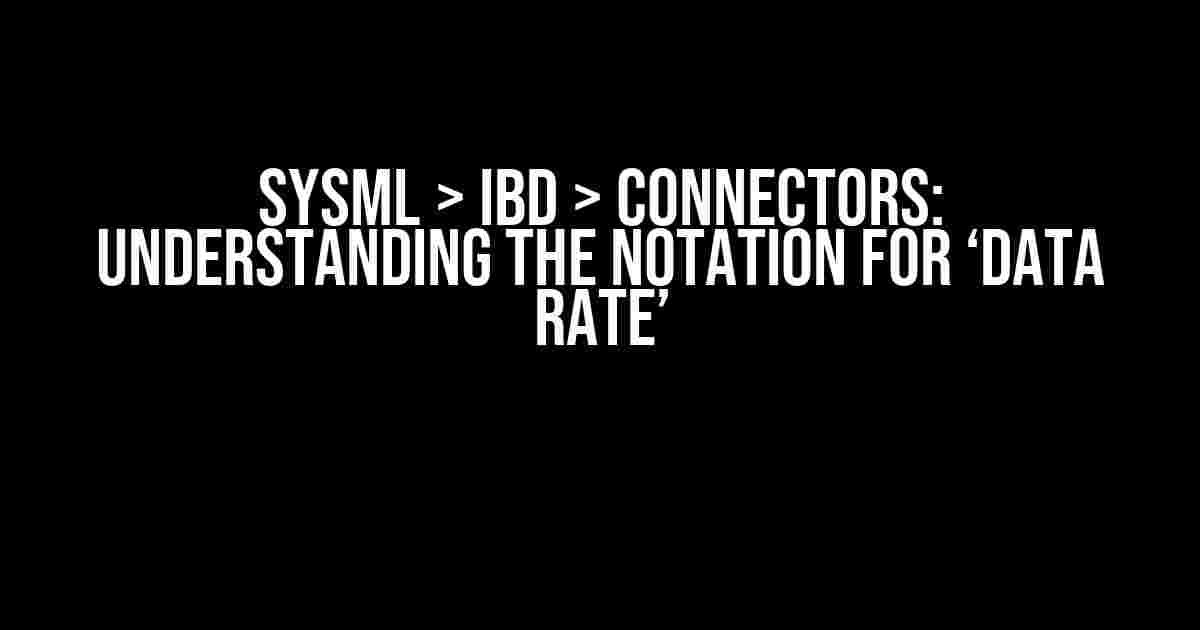In systems modeling language (SysML), the internal block diagram (IBD) is a crucial tool for designing and analyzing complex systems. When it comes to connectors, an essential aspect of IBD, a common question arises: Is there a customary and agreed notation for representing ‘data rate’?
The Answer
In SysML, there is no standardized notation for representing ‘data rate’ in IBD connectors. However, there are some guidelines and best practices that can help you effectively convey this information.
Using Stereotypes
One approach is to use stereotypes to extend the connector’s properties. For example, you can create a stereotype like «DataRate» and add a tagged value to specify the data rate, such as «bandwidth» or «throughput».
Using Properties
Another approach is to define a property on the connector to represent the data rate. This can be done by creating a custom property, such as “dataRate”, and assigning a value to it, such as “100 Mbps” or “1 Gb/s”.
Using the SysML Standard
The SysML standard provides a set of standard properties for connectors, including «probability» and «weight». While there is no specific property for data rate, you can use the «weight» property as a proxy to represent the data rate, with the understanding that the weight corresponds to the data rate.
Best Practices
When representing data rate in IBD connectors, it’s essential to follow some best practices:
- Use a consistent notation throughout your model.
- Define a clear and concise naming convention for your stereotypes or properties.
- Document your notation and conventions in your model’s documentation.
By following these guidelines and best practices, you can effectively represent data rate in your IBD connectors and ensure clarity and consistency in your SysML models.
Frequently Asked Question
Are you scratching your head over the notation for ‘data rate’ in SysML, IBD, and connectors? Well, you’re in luck! We’ve got the answers to your most pressing questions.
Is there a standard notation for ‘data rate’ in SysML, IBD, and connectors?
Unfortunately, there isn’t a single, universally agreed-upon notation for ‘data rate’ in SysML, IBD, and connectors. However, SysML v2 addresses this issue by introducing a notation called “rate” which can be used to specify data rates.
What is the significance of data rate notation in SysML, IBD, and connectors?
Data rate notation plays a crucial role in SysML, IBD, and connectors as it enables modelers to specify the rate at which data flows between components, facilitating accurate system design, analysis, and simulation.
How can I represent data rate in SysML, IBD, and connectors if there’s no standard notation?
In the absence of a standard notation, you can use a custom notation that suits your specific needs. Many modelers use an annotation or a stereotype to indicate the data rate, such as <> or [dataRate: X Mbps]. It’s essential to document and communicate your chosen notation to ensure consistency across your team and models.
Can I use SysML v1.x to model data rates?
While SysML v1.x doesn’t provide a native notation for data rates, you can still use it to model data rates by employing workarounds like custom stereotypes, annotations, or even UML extensions. However, these approaches may not be as elegant or intuitive as using SysML v2’s built-in “rate” notation.
Will there be future developments in SysML, IBD, and connectors to support data rate notation?
The OmniGraffle SysML plugin, for instance, already supports data rate notation. As the SysML and OMG communities continue to evolve, we can expect to see further developments and refinements in data rate notation and modeling capabilities.
